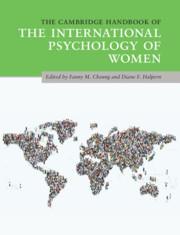Book contents
- The Cambridge Handbook of the International Psychology of Women
- The Cambridge Handbook of the International Psychology of Women
- Copyright page
- Dedication
- Contents
- Figures
- Tables
- Contributors
- Acknowledgments
- Section 1 The Underpinnings of Sex and Gender and How to Study Them
- Section 2 Developmental Perspectives of the International Psychology of Women
- Section 3 Cognitive and Social Factors
- Section 4 Work and Family Issues
- Section 5 Inequality and Social Justice
- Section 6 Health and Well-Being
- 31 Happiness across Cultures and Genders
- 32 Women under Pressure
- 33 Gender and Women’s Sexual and Reproductive Health
- 34 Physical Health
- 35 Women and Suicidal Behavior
- 36 Sex and Gender in Psychopathology
- 37 Women and Psychotherapy
- Epilogue Some Final Thoughts and Take-Home Messages
- Index
- References
31 - Happiness across Cultures and Genders
Universals, Variations, and Remaining Questions
from Section 6 - Health and Well-Being
Published online by Cambridge University Press: 20 July 2020
- The Cambridge Handbook of the International Psychology of Women
- The Cambridge Handbook of the International Psychology of Women
- Copyright page
- Dedication
- Contents
- Figures
- Tables
- Contributors
- Acknowledgments
- Section 1 The Underpinnings of Sex and Gender and How to Study Them
- Section 2 Developmental Perspectives of the International Psychology of Women
- Section 3 Cognitive and Social Factors
- Section 4 Work and Family Issues
- Section 5 Inequality and Social Justice
- Section 6 Health and Well-Being
- 31 Happiness across Cultures and Genders
- 32 Women under Pressure
- 33 Gender and Women’s Sexual and Reproductive Health
- 34 Physical Health
- 35 Women and Suicidal Behavior
- 36 Sex and Gender in Psychopathology
- 37 Women and Psychotherapy
- Epilogue Some Final Thoughts and Take-Home Messages
- Index
- References
Summary
This chapter provides a review of subjective well-being (SWB), with focus on the universals and cultural differences in the effects and predictors of SWB. In addition, we discuss the current contradictions in the SWB literature regarding gender differences in the mean levels of SWB. We provide an in-depth consideration of focused cultural regions and discuss the ways in which both culture and gender impact SWB.
Keywords
- Type
- Chapter
- Information
- The Cambridge Handbook of the International Psychology of Women , pp. 451 - 458Publisher: Cambridge University PressPrint publication year: 2020
References
Suggested Readings

Chu Kim-Prieto is a Professor of Psychology at the College of New Jersey. She was born in Korea and grew up in the USA. She earned her PhD at the University of Illinois, Urbana-Champaign. Chu teaches courses in psychology of emotion and happiness, research methods, and psychology of racism. Her research focuses on the effects of everyday emotions, as well as the effects of stereotypes and micro-aggressions.

Megan Heye earned her BA in Psychology, with a specialization in Biopsychology, at the College of New Jersey. She has conducted research on cognition throughout the aging process, and the relationship between emotions and micro-aggressions in the LGBTQ community, as well as between emotions and exercise. Currently, she is applying to doctoral programs for clinical neuropsychology.

Kai Mangino was born in China, but was adopted at a young age and grew up in New Jersey. She is a psychology student at the College of New Jersey. She is actively involved in the Bonner Community Scholars Program at the college along with her research in the psychology department. She has conducted research on the cognitive development of infants as well as studies analyzing the relationship between emotion and other factors such as exercise and LGBTQ micro-aggressions. Currently, she is completing her honors thesis on the effects of racial micro-aggressions on bystanders’ perceptions of stereotypes and modern-day racism attitudes. She will attend the University of Hartford for graduate school. She strongly identifies as an Asian American. She is also a feminist and tries to embrace a social justice mindset as she goes through life.



